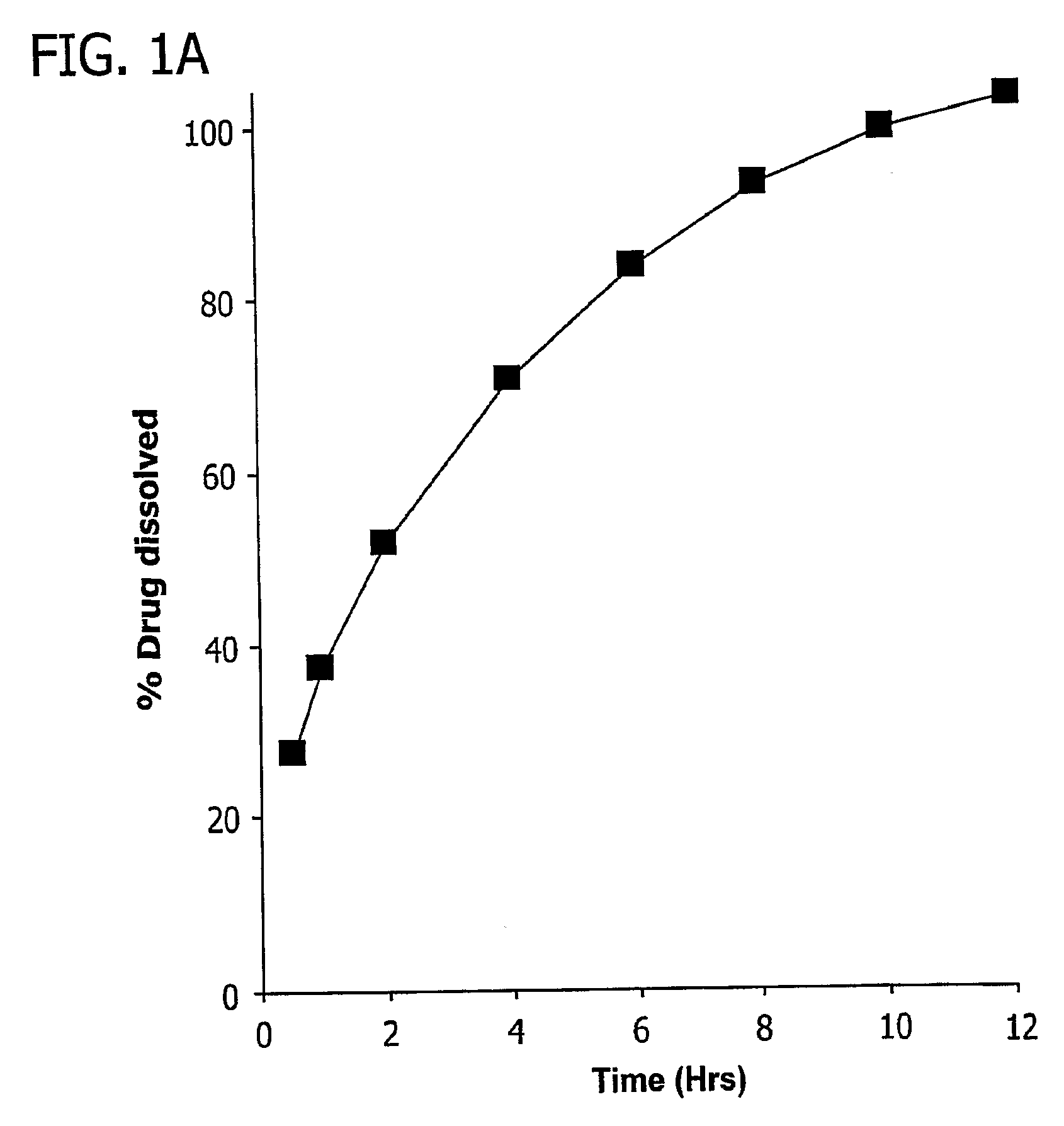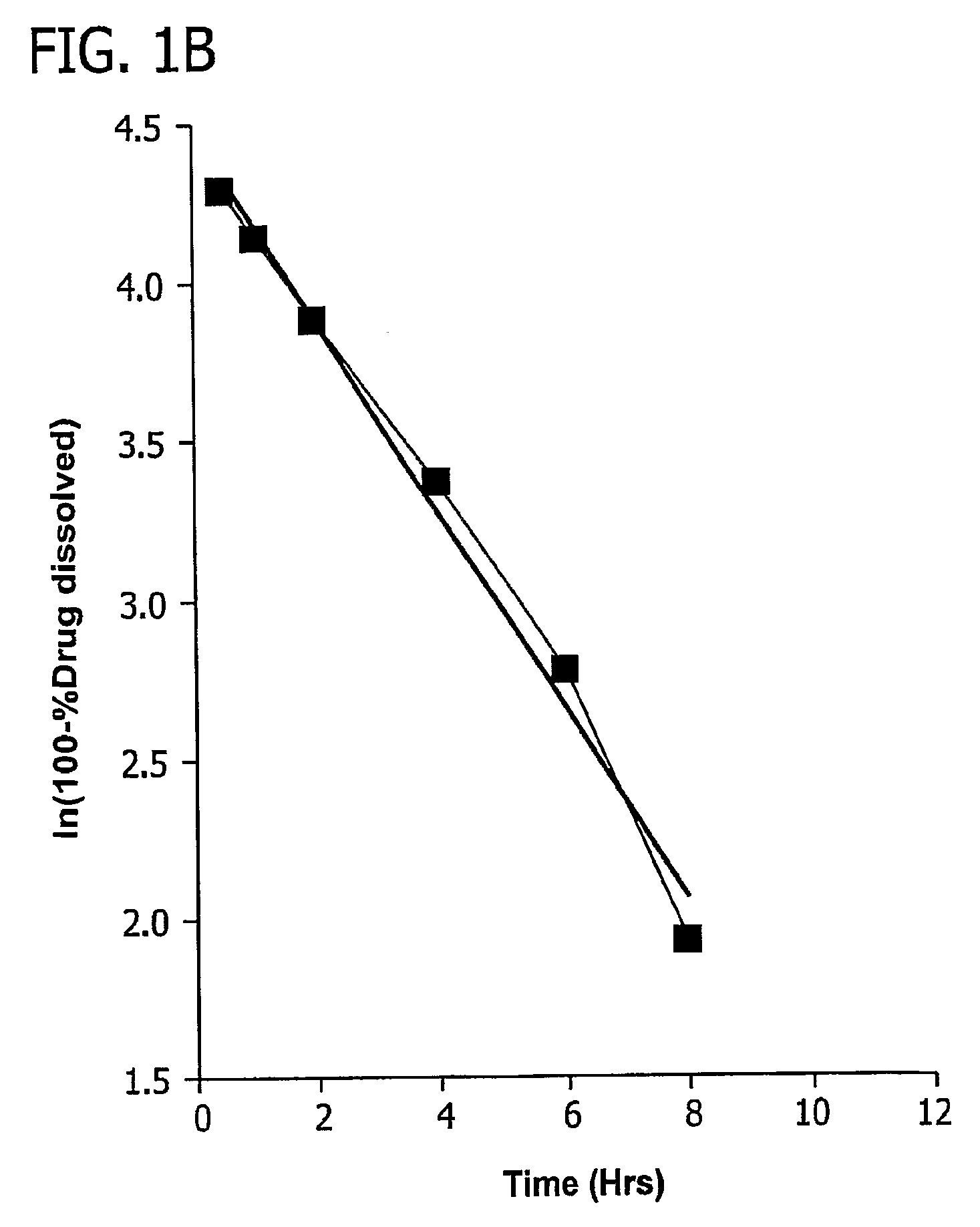Zero-Order Modified Release Solid Dosage Forms
a technology of modified release and solid dosage form, which is applied in the direction of heterocyclic compound active ingredients, biocide, drug compositions, etc., can solve the problems of drug overdosing, drug being dumping into the bloodstream, and difficult to formulate highly water soluble pharmaceutical agents in such a dosage form,
- Summary
- Abstract
- Description
- Claims
- Application Information
AI Technical Summary
Problems solved by technology
Method used
Image
Examples
example 1
[0076]Methylphenidate hydrochloride was placed in a V-blender with ethyl cellulose, hydroxypropyl cellulose and silicified microcrystalline cellulose and mixed for five minutes. Thereafter, magnesium stearate was added as a lubricant and the mixture was mixed for another five minutes. Then, the mixture was compressed using a Korsch PH 106 tablet press under ambient conditions to form a matrix core. The matrix core contained the ingredients in the table below.
IngredientWeight (mg)Methylphenidate HCl21Hydroxypropyl Cellulose (KLUCEL ™ HXF)25Ethyl cellulose (AQUALON ™ T10 EC)75Silicified Microcrystalline Cellulose (PROSOLV ™ HD90)126.5Magnesium Stearate2.5Total250
[0077]The methylphenidate hydrochloride was the water soluble pharmaceutical agent, ethyl cellulose was the hydrophobic material, high viscosity hydroxypropyl cellulose was the release modifier, silicified microcrystalline cellulose was a filler, and magnesium stearate was used as a lubricant.
[0078]In one embodiment, the table...
example 2
[0080]A matrix core was produced according to the method of production of example 1. The matrix core contained the ingredients in the table below.
IngredientWeight (mg)Methylphenidate HCl21Glyceryl Behenate (COMPRITOL ™ 888 ATO)31.25Hydroxypropyl Cellulose (KLUCEL ™ EF)12.25Silicified microcrystalline Cellulose (PROSOLV ™ HD90)185.25Colloidal Silicon Dioxide5.0Total255
[0081]The methylphenidate hydrochloride was the water soluble pharmaceutical agent, low viscosity hydroxypropyl cellulose was used as a release modifier, glyceryl behenate was added as both the hydrophilic material and as a lubricant, silicified microcrystalline cellulose was a filler, and colloidal silicon dioxide was used as a glidant.
[0082]In one embodiment, the tablets were not coated. The release characteristics of the tablets were tested by placing tablets in 0.1% formic acid aqueous solution (pH 2.6). USP paddle apparatus was used at 50 rpm to mix the tablets in the acid solution. A total volume of 500 ml of the ...
example 3
[0084]After the matrix cores of example 1 were formed, they were coated with a coating comprising 80% SURELEASE™ and 20% OPADRY™ (% w / w solid content). The tablets were coated with varying quantities of coating, up to 8 wt. % based on weight gain of the tablet, and some tablets were not coated. The preferred amount of coating to achieve a zero-order release profile was experimentally determined by placing tablets in 0.1% formic acid aqueous solution (pH 2.6). USP paddle apparatus was used at 50 rpm to mix the tablets in the acid solution. A total volume of 500 ml of the dissolution media was used. At 30 minutes, 1 hour, 2 hours, 4 hours, 6 hours, 8 hours, 10 hours, and 12 hours, the amount of methylphenidate hydrochloride dissolved in each trial run was determined. The experimental results are depicted in FIG. 5A, and were determined via UV spectroscopy at 200 nm. FIG. 5B is a plot of ln (100-% methylphenidate hydrochloride dissolved) as a function of time and indicates zero order d...
PUM
| Property | Measurement | Unit |
|---|---|---|
| dinner time | aaaaa | aaaaa |
| pH | aaaaa | aaaaa |
| total volume | aaaaa | aaaaa |
Abstract
Description
Claims
Application Information
 Login to View More
Login to View More - R&D
- Intellectual Property
- Life Sciences
- Materials
- Tech Scout
- Unparalleled Data Quality
- Higher Quality Content
- 60% Fewer Hallucinations
Browse by: Latest US Patents, China's latest patents, Technical Efficacy Thesaurus, Application Domain, Technology Topic, Popular Technical Reports.
© 2025 PatSnap. All rights reserved.Legal|Privacy policy|Modern Slavery Act Transparency Statement|Sitemap|About US| Contact US: help@patsnap.com



